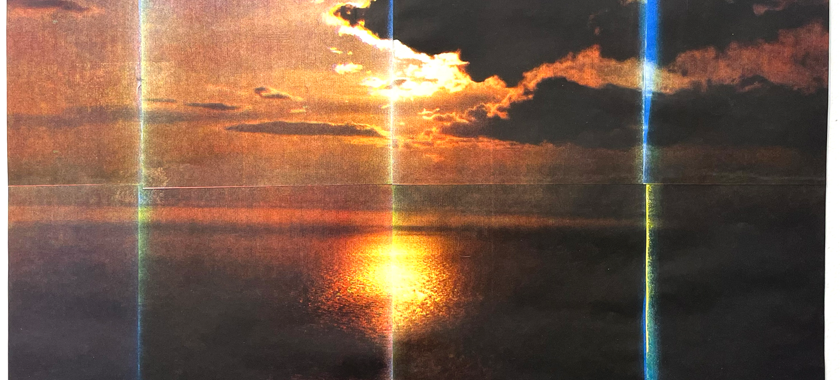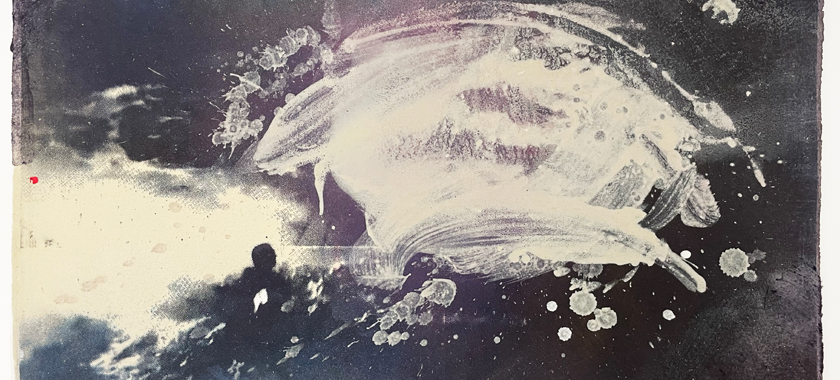Displaced in Fragmented Narratives: A Conversation with Nazanin Noroozi
Multidisciplinary artist Nazanin Noroozi shares her experience establishing her career in the U.S. and her new project addressing notions of displacement and collective memory.
Nazanin Noroozi, a NYSCA/NYFA Artist Fellow (2021) and IAP Mentee (2018), explores the fragile idea of home that never materializes by working with imperfect archival materials. She shared challenges she faced when establishing her career in the U.S. and resources she turned to, as well as tips on writing.
New York Foundation for the Arts (NYFA): Your work is about the idea of collective loss and displacement. Share with us what you are working on and how your experience as someone who moved from one place to another shapes your work, if at all?
Nazanin Noroozi (NN): I’m currently working on a project tentatively called False Dawn, (Zodiacal Light), that is based on found footage and media images of stranded migrant boats and the refugee crisis at the Mediterranean shores. This project consists of handmade film with a digital video projection, 35mm slideshow, and some sculptural artist books laid on pedestals for viewers to touch and interact with. I’m trying to salvage these viral images from the fast-paced news cycles and give them a second life by juxtaposing them with hand-painted Super 8 family movies and amateur 35mm slides of American landscapes to address notions of displacement and collective memory.
I often begin with a photo-based image and usually use alternative photography and printmaking processes to manipulate archival materials. My recent films are based on found footage and Super 8 movies my father took in the late 70s in post-revolution Iran. Each film consists of over 2,000 frames that are hand-painted and then scanned individually. For example, one minute of the film has 600 single frames that I paint on and then scan. It is a labor intensive and slow process, but I think the painterly quality of washes and stains can only be achieved with this method. And it is by painting and using printmaking techniques on top of archival materials that I can abstract images to create ambiguous representations of historical events and collective memories.
My work usually navigates between traditional stop-motion, experimental filmmaking, papermaking, and printmaking while addressing the contemporary language of mark-making. I think archives as modes of cultural transmission can’t be completely trusted so I’d like to invite the viewers into these fragmented narratives based on stories that are told by others, to reflect on the idea of displacement.
Culturally, my work has been informed by extreme forms of duality between inside/outside and private/public spheres in contemporary Iran and the many other middle eastern countries. The constant sense of loss and instability in addition to this duality has created a type of fragile sense of being in the day-to-day life of people that I’m interested in.
I think archives as modes of cultural transmission can’t be completely trusted so I’d like to invite the viewers into these fragmented narratives based on stories that are told by others, to reflect on the idea of displacement.
Nazanin Noroozi

NYFA: Share with us your experience establishing your career in a new country. What was the most challenging part and what resources did you turn to?
NN: I first entered the U.S. as an international student to go to grad school, so I think I had the privilege of being able to build a community and a network of like-minded people from the beginning.
Building a career from scratch when you’re an immigrant and new to a country can be quite challenging as we all know. Figuring out how to find your artistic path in the art world that is built on the combination of complex connections, hierarchy, and multiple opportunities while navigating the faulty U.S. immigration system at the same time can be frustrating. I think the biggest challenge was figuring out how to remain genuine and focused on your studio practice while finding ways to represent your work and dealing with the seemingly endless paperwork for the immigration process.
I am a true believer in community and the power it has in supporting artists’ careers. I welcome any opportunity to connect and build a genuine relation with like-minded creative individuals. I believe that art is always about art, and I’m interested in artistic exchanges and mentorship in mediums that I’m not trained in academically. So, I actively seek feedback from my peers, alternative spaces, and art institutions to navigate my way. Resources such as NYFA and Creative Capital’s listings were especially helpful in finding opportunities and learning about arts organizations.
NYFA: In 2018, you participated as a mentee in the Immigrant Artist Mentoring Program; in 2021, you received a NYSCA/NYFA Artist Fellowship. What advice would you give immigrant artists in terms of writing narratives and artist statements?
NN: I’m a visual artist, so writing has always been challenging for me. It is more natural for some people, I guess, though I’ve been an avid reader all my life and literature has influenced my work strongly. I think the best approach would be to write clean statements that focus on two or three crucial questions/problems addressed in your work. Think deeply about what we want to say, and just say what we believe in.
Artist statements are often very short. You are given a small window to talk about your work to people who are not familiar with your work and thought process. So, it is important to express the most important aspects of your work, rather than going into details. I’d also like to add that the images and the text submitted should correspond. The readers should be able to see the visual equivalents of what you said in the materials submitted.
Think deeply about what we want to say, and just say what we believe in.
Nazanin Noroozi
NYFA: Where do you see yourself going in terms of being an artist in the next three to five years?
NN: It’s hard to say. These days, I’m actively thinking about a multi-media installation that utilizes all different aspects and mediums of my work, such as experimental film, handmade paperwork, artist books, and prints. I’d like to work on site specific video installations, and have access to bigger spaces to do projects that I can’t do in a small studio. I don’t really have a grand plan for my projects, and usually one project leads me to the next and I like the surprises and the unexpected nature of this type of work.

About Nazanin Noroozi
Nazanin Noroozi is a multi-disciplinary artist who works with moving images, printmaking, and alternative photography processes. Her work is about the ideas of collective loss and displacement as expressed through imperfect materials, poorly framed or overexposed family photos, shaky or blurred amateur clips, or pixelated, low quality video recordings. Images in Noroozi’s work serve as vehicles for alternative versions of history, memory, people, and place. Moving between still images and time-based mediums, she uses archeology of technologies such as Super 8 home-videos and early computer graphics to explore the fragile idea of home that never materializes.
Noroozi’s work has been widely exhibited at galleries and museums across the world including SPACES, Cleveland, OH; Athopos, Athens, Greece; Golestani Gallery, Dusseldorf, Germany; Immigrant Artist Biennial, NARS, Brooklyn; Noyes Museum of Art, New Jersey; as well as NY Live Arts, School of Visual Arts, and Postcrypt Art Gallery at Columbia University in New York.
She is the recipient of awards and fellowships from New York Foundation for the Arts Fellowship (film and video), Marabeth Cohen-Tyler Print/Paper Fellowship at Dieu Donne, Artistic Freedom Initiative, Elizabeth Foundation for the Arts, and Mass MoCA residency. She is an editor at large of Kaarnamaa; A Journal of Art History and Criticism. Noroozi completed her MFA degree in painting and drawing from Pratt Institute. Her works have been featured in various publications and media including British Journal of Photography, Die Zeit Magazine, Evergreen Review, BBC, Elephant Magazine, Financial Times, and Brooklyn Rail. She lives and works in New York City.
–Ya Yun Teng, Program Officer, Immigrant Artist Program
This post is part of the ConEdison Immigrant Artist Program Newsletter #172. Subscribe to this free monthly e-mail for artist’s features, opportunities, and events. Learn more about NYFA Immigrant Artist Mentoring Program.





